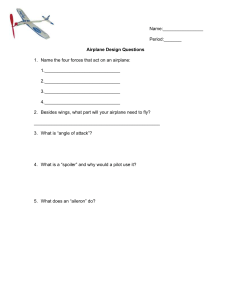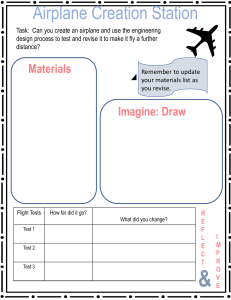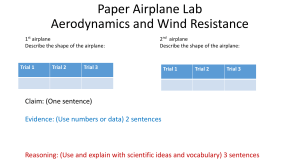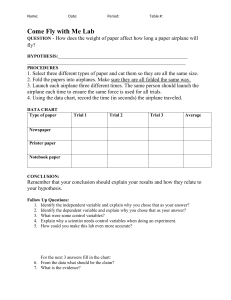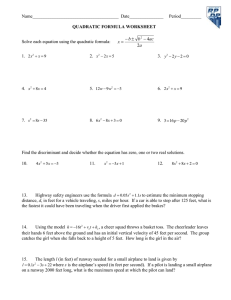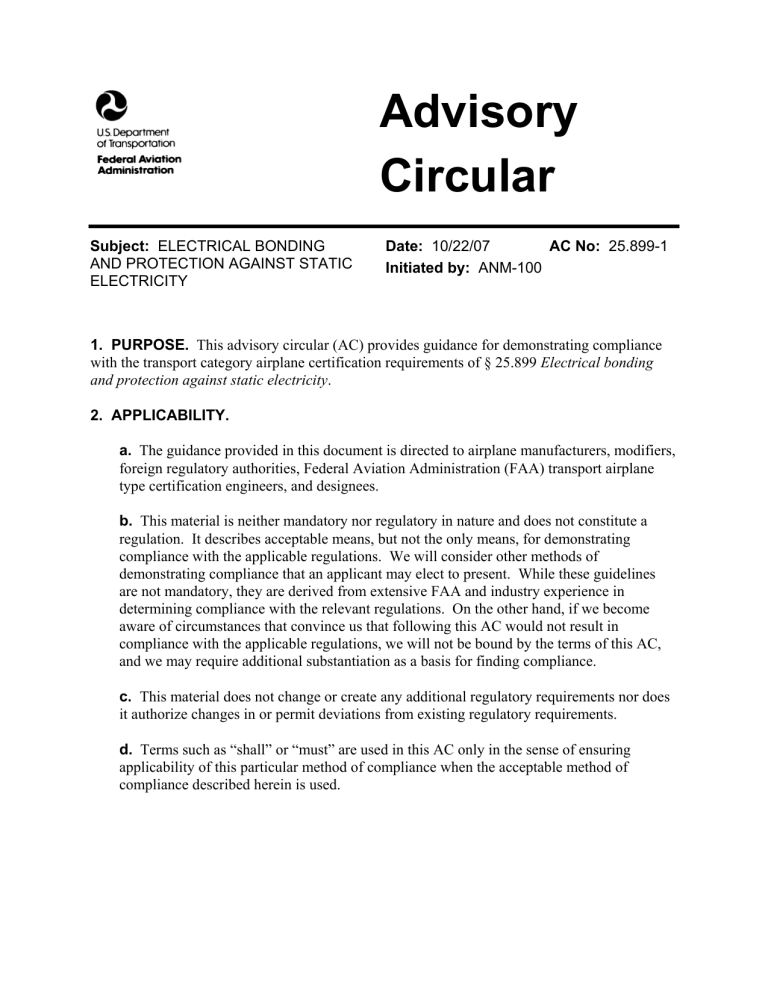
Advisory Circular Subject: ELECTRICAL BONDING AND PROTECTION AGAINST STATIC ELECTRICITY Date: 10/22/07 AC No: 25.899-1 Initiated by: ANM-100 1. PURPOSE. This advisory circular (AC) provides guidance for demonstrating compliance with the transport category airplane certification requirements of § 25.899 Electrical bonding and protection against static electricity. 2. APPLICABILITY. a. The guidance provided in this document is directed to airplane manufacturers, modifiers, foreign regulatory authorities, Federal Aviation Administration (FAA) transport airplane type certification engineers, and designees. b. This material is neither mandatory nor regulatory in nature and does not constitute a regulation. It describes acceptable means, but not the only means, for demonstrating compliance with the applicable regulations. We will consider other methods of demonstrating compliance that an applicant may elect to present. While these guidelines are not mandatory, they are derived from extensive FAA and industry experience in determining compliance with the relevant regulations. On the other hand, if we become aware of circumstances that convince us that following this AC would not result in compliance with the applicable regulations, we will not be bound by the terms of this AC, and we may require additional substantiation as a basis for finding compliance. c. This material does not change or create any additional regulatory requirements nor does it authorize changes in or permit deviations from existing regulatory requirements. d. Terms such as “shall” or “must” are used in this AC only in the sense of ensuring applicability of this particular method of compliance when the acceptable method of compliance described herein is used. 10/22/07 AC 25.899-1 3. DEFINITIONS. Electrical Wiring Interconnection Systems (EWIS). In part, an EWIS is any wire, wiring device, or combination of these, including termination devices, installed in any area of the airplane for the purpose of transmitting electrical energy between two or more intended termination points. The complete regulatory definition of an EWIS is in § 25.1701, which is included in Appendix A of this AC. 4. COMPLIANCE GUIDANCE. a. Protection Against Accumulation of Static Charges. (1) General. All items that may cause a danger of • electrical shock, • ignition of flammable vapors, or • interference with installed electrical/electronic equipment (e.g., radio communications and navigational aids) as a result of accumulation and discharge of static charges should be adequately bonded to the main grounding systems. (2) Intermittent contact. The design should ensure that no intermittent contact can occur between metallic and/or metalized parts. (3) High pressure refueling and fuel transfer. High pressure refueling and/or high rates of fuel transfer must not induce dangerously high voltages within the fuel system. Prevention of such an occurrence should be established by test or by consultation with the appropriate fuel and refueling equipment manufacturers. If compliance with this requirement involves any restriction on the types of fuel to be used or on the use of additives, these restrictions should be established. (a) With standard refueling equipment and standard airplane turbine fuels, voltages high enough to cause sparking may be induced between the surface of the fuel and the metal parts of the tank at refueling flow velocities above approximately 7 meters/second (23 feet/second). These induced voltages may be increased by − • The presence of additives and contaminants (e.g., anti-corrosion inhibitors, lubricating oil, free water). • Splashing or spraying of the fuel in the tank. (b) The static charge can be reduced by – 1 adjusting the refueling equipment, such as by increasing the diameter of refueling lines and designing filters to give the minimum of electrostatic charging, or 2 10/22/07 AC 25.899-1 2 changing the electrical properties of the fuel with anti-static additives, thus reducing accumulation of static charge in the tank to negligible amount, or 3 adjusting the critical refueling rates. Critical refueling rates are related to the airplane refueling installations and the designer should seek the advice of fuel suppliers on this problem. b. Bonding Paths. (1) There are two kinds of bonding paths: • Primary bonding paths are those paths that are required to carry lightning discharge currents. These paths should be as short as practicable with low electrical resistance. • Secondary bonding paths are those paths provided for other forms of bonding. (2) Primary bonding paths should be used as follows: (a) To connect together the main grounds of separable major components that may carry lightning discharges. (b) To connect engines to the main ground. (c) To connect all metal parts presenting a surface on or outside of the external surface of the airplane to the main ground. (d) To serve as conductors on external non-metallic parts. c. Resistance and Continuity Measurements. Measurements should be made to determine the efficacy of the bonding and connection between at least the following: (1) Primary bonding paths. (a) The extremities of the fixed portions of the airplane and any fixed external panels and components where the method of construction or assembly leads to doubt about the repeatability of the bond (for example, removable panels). (b) The engines and the main airplane ground. (c) External movable metal surfaces or components and the main airplane ground. (d) The bonding conductors of external non-metallic parts and the main airplane ground. 3 10/22/07 AC 25.899-1 (e) Internal components for which a primary bond is specified and the main airplane ground. (2) Secondary bonding paths. (a) Metallic parts normally in contact with flammable fluids and the main airplane ground (airplane main structure or ground path). (b) Isolated conducting parts subject to appreciable electrostatic charging and the main airplane ground (airplane main structure or ground path). (c) Electrical panels and other equipment accessible to the occupants of the airplane and the main airplane ground (airplane main structure or ground path). (d) Ground connections that normally carry the main electrical supply and the main airplane ground (airplane main structure or ground path). The test on these connections should ensure that the connections can carry, without risk of fire or damage to the bond or excessive volt drop, such continuous normal currents and intermittent fault currents as are applicable. (e) Electrical and electronic equipment and the airplane main ground (airplane main structure or ground path), where applicable, and as specified by the airplane manufacturer. (f) Static discharger wicks and the main airplane structure. d. Electrical Properties of Composite Structure. (1) In the case of lightning protection for composite structure, the method of surface protection will vary with the criticality of the structure in question. You should consider the deterioration of the protection means, or possible hidden damage to the material that may affect its structural integrity. While such materials provide a measure of electro-magnetic screening, the need for additional measures will be a function of the location of the material in relation to critical equipment and wiring in the aircraft. You should also give particular attention to the protection required near fuel systems (for example, fuel tanks). For non-conducting materials that have no intrinsic lightning protection or screening properties, the measures taken will again depend on the relative locations of the material and critical systems or fuel, and the possible loss of the components due to internal air pressures in the event of a strike. (2) Partial conducting materials should present no problem in dissipating P-static, but problems can arise with the non-conductors. Protection may be required, depending on the location of the material. (3) Electrical currents, other than lightning, can flow in some partial conducting materials. If the effect of large voltage drop is important, or if such currents can 4 10/22/07 AC 25.899-1 damage the material, alternative current paths may be required in order to limit current flow. (4) You should take particular care to ensure that all joints, permanent and temporary, are capable of carrying any currents that may flow, particularly those resulting from lightning strikes. Structural damage and loss of screening capabilities may occur if these are not adequately controlled. (5) You may have to consider the adequacy of the material in supplying a ground plane for antennas. Again, it will vary with the material and the radio frequency of the system. e. Compliance with § 25.1717. Section 25.1717 requires that EWIS components used for electrical bonding and protection against static electricity meet the requirements of § 25.899. f. Instructions for Continued Airworthiness. Instructions for Continued Airworthiness (required by §§ 25.1529 and 25.1729) must include all maintenance actions necessary to ensure that components used for electrical bonding and protection against static electricity are maintained so that they continue to perform their intended function throughout the expected service life of the airplane. /s/Ali Bahrami Ali Bahrami Manager, Transport Airplane Directorate Aircraft Certification Service 5 10/22/07 AC 25.899-1 Appendix A APPENDIX A The text of §§ 25.899 and 25.1701 is repeated here for the convenience of the reader. § 25.899 Electrical bonding and protection against static electricity. (a) Electrical bonding and protection against static electricity must be designed to minimize accumulation of electrostatic charge that would cause − (1) Human injury from electrical shock, (2) Ignition of flammable vapors, or (3) Interference with installed electrical/electronic equipment. (b) Compliance with paragraph (a) of this section may be shown by − (1) Bonding the components properly to the airframe; or (2) Incorporating other acceptable means to dissipate the static charge so as not to endanger the airplane, personnel, or operation of the installed electrical/electronic systems. § 25.1701 Definition. (a) As used in this chapter, electrical wiring interconnection system (EWIS) means any wire, wiring device, or combination of these, including termination devices, installed in any area of the airplane for the purpose of transmitting electrical energy, including data and signals, between two or more intended termination points. This includes: (1) Wires and cables. (2) Bus bars. (3) The termination point on electrical devices, including those on relays, interrupters, switches, contactors, terminal blocks, and circuit breakers and other circuit protection devices. (4) Connectors, including feed-through connectors. (5) Connector accessories. (6) Electrical grounding and bonding devices and their associated connections. A-1 10/22/07 AC 25.899-1 Appendix A (7) Electrical splices. (8) Materials used to provide additional protection for wires, including wire insulation, wire sleeving, and conduits that have electrical termination for the purpose of bonding. (9) Shields or braids. (10) Clamps and other devices used to route and support the wire bundle. (11) Cable tie devices. (12) Labels or other means of identification. (13) Pressure seals. (14) EWIS components inside shelves, panels, racks, junction boxes, distribution panels, and back-planes of equipment racks, including, but not limited to, circuit board back-planes, wire integration units, and external wiring equipment. (b) Except for the equipment indicated in paragraph (a)(14) of this section, EWIS components inside the following equipment, and the external connectors that are part of that equipment, are excluded from the definition in paragraph (a) of this section: (1) Electrical equipment or avionics that are qualified to environmental conditions and testing procedures when those conditions and procedures are— (i) appropriate for the intended function and operating environment, and (ii) acceptable to the FAA. (2) Portable electrical devices that are not part of the type design of the airplane. This includes personal entertainment devices and laptop computers. (3) Fiber optics. A-2 10/22/07 AC 25.899-1 Appendix B APPENDIX B RELATED REGULATIONS AND DOCUMENTS Regulations. You can download an electronic copy of 14 CFR from the Internet at http://www.gpoaccess.gov/cfr/. A paper copy can be ordered by sending a request to the U.S. Superintendent of Documents, U.S. Government Printing Office, Washington, D.C. 20402-0001, or by calling telephone number (202) 512-1800; or by sending a request by facsimile to (202) 512-2250. • • • • • • • • • § 25.581 § 25.954 § 25.1316 § 25.1353 § 25.1360 § 25.1529 § 25.1717 § 25.1719 § 25.1729 Lightning protection Fuel system lightning protection System lightning protection Electrical equipment and installations Precautions against injury Instructions for continued airworthiness Circuit protective devices: EWIS Accessibility provisions: EWIS Instructions for continued airworthiness: EWIS Advisory Circulars. You can download an electronic copy of the latest version of the following ACs from the FAA Internet at http://rgl.faa.gov. • • • • • 20-53B Protection of Aircraft Fuel Systems Against Fuel Vapor Ignition Caused by Lightning 20-136A Protection of Aircraft Electrical/Electronic Systems Against the Indirect Effects of Lightning 25.1353-1A Electrical Equipment and Installations 25-1360-1 Protection Against Injury 25.1701-1 Certification of Electrical Wiring Interconnection Systems on Transport Category Airplanes Reports. You can download an electronic copy of the following report from the “Final Reports” section of the Aging Transport Systems Rulemaking Advisory Committee (ATSRAC) website: www.mitrecaasd.org/atsrac. “Task 6 Final Report,” dated October 29, 2002, Aging Transport Systems Rulemaking Advisory Committee. B-1 10/22/07 AC 25.899-1 Appendix C APPENDIX C Following is the discussion of § 25.899 published in the Federal Register on October 6, 2005 (70 FR 58508), in Notice of Proposed Rulemaking No. 05-08, Enhanced Airworthiness Program for Airplane Systems/Fuel Tank Safety (EAPAS/FTS), at the time this rule was proposed. Section 25.899 Electrical bonding and protection against static electricity. Proposed § 25.899 would contain requirements for electrical bonding and protection against static electricity. Current §§ 25.581, 25.954, and 25.1316 contain requirements for protecting the airplane and its systems from the effects of lightning strikes. But the current requirements do not address the hazards that could occur because of the accumulation of electrostatic charge. Static electricity can cause electrical shock hazards to people, ignite fuel vapors, and cause electromagnetic interference of airplane systems. Proposed § 25.899 would require that electrical bonding and protection against static electricity be designed to minimize accumulation of electrostatic charge that could cause human injury from electric shock, ignition of flammable vapors, or interference with electrical and electronic equipment. Compliance could be shown by bonding the components properly to the airframe or by incorporating other acceptable means to dissipate static charge This proposal would adopt a modified version of the current proposed JAR 25X899. As currently written, the JAR duplicates some of the lightning protection requirements of JARs 25.581, 25.985, and 25.1316. That proposed JAR 25X899 will be revised as well, and those duplications removed, for the purposes of this harmonization. There is currently no § 25.899. This new requirement is necessary to ensure electrical bonding and static protection is fully addressed as a design standard. Proposed § 25.899 maintains the same level of safety as currently exists because it reflects and codifies current industry practices. The proposed change would affect airplane manufacturers by requiring compliance with the new sections of the regulations. However, this would have a minimal effect in practice because airframe manufacturers must comply with proposed standards when seeking joint FAA-JAA certification of their products, so there would be little change required from the standards they have been using to comply with the existing proposed JAR 25X899. The FAA has developed advisory material about the requirements for bonding and static electricity protection in transport category airplanes. This material is contained in proposed AC 25.899-1. C-1
